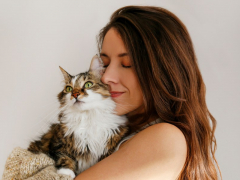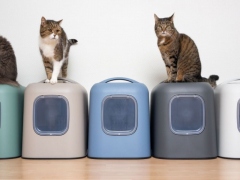
eeechos / Shutterstock.com
Kittens are born 12 months out of the year, but shelters see a massive influx of kittens beginning in late March to early April. This is commonly referred to as kitten season. It peaks around June and July and doesn’t taper off until the fall months.
Unfortunately, most of these kittens find themselves without homes. Some litters are turned over to shelters until they are ready to go to their forever homes. These cats and kittens will have the brightest futures if they make their way to humane animal shelters. But how do you know which those are?
Key Characteristics of No-Kill Shelters

A female rescue volunteer hoses down cat beds and floors with an orange pressure hose. Microfile.org / Shutterstock.com
Are no-kill shelters the most humane option for cats? Well, it’s important to note that there isn’t a governing body regulating what it means to be “no-kill.” You may be surprised to learn that “no-kill” doesn’t always mean that animals are never euthanized in these facilities.
Most animal shelters aim to find homes for at least 90% of the animals they house. But for those who have incurable or unmanageable ailments, euthanasia may be the most humane option, rather than leaving them to suffer in a cage. Their quality of life is what matters most. For this reason, some animal rescues choose to adopt no-kill principles without using the label.
Quality of Life
One characteristic of a no-kill shelter is a willingness to save every cat that has the potential to go on to live a happy and healthy life. Teams of experts and volunteers work tirelessly to ensure cats receive the right support for their needs.
Mother and Kitten Support
Quality shelters are likely to have resources available to support pregnant and postpartum cats and their new kittens. These cats require special diets of nutritious, high-calorie food. They will often need close monitoring and regular medical exams.
Low-Income Support
Caring for a pet can be a significant investment, especially when medical treatment is needed. In lower income areas, owners are likely to need some additional support. Shelters in these areas may assist their community with free spay and neuter services, discounted food banks, or pay-what-you-can vet exams.
Local Collaboration
Successful no-kill shelters often collaborate with other animal welfare groups to save all viable cats. Communities will take a collective responsibility for the outcome, moving everyone toward their goal.
One of the most important goals is to spay or neuter all cats who enter the shelter. They may work with local vets to make this happen. They also partner with local foster groups so animals spend less time in the shelter and find homes quickly.
No-kill shelters work together from county to county. Volunteers and rescues help with kitten and cat transportation, reducing overcrowding, and putting cats in front of potential adopters.
Trap-Neuter-Return Programs
No-kill shelters work to reduce the feral cat population through trap-neuter-release programs (TNR) or return-to-field programs. Feral cats differ from stray cats since they cannot be domesticated and adopted out. So to help their populations from getting out of control, TNR programs work to capture feral cats, spay or neuter them, and then return them to live out their wild-cat lives. Shelters may also help with relocating feral cats to appropriate locations, such as human-managed cat colonies or farms with barns.
History and Evolution of the No-Kill Movement

An orange hose sits on the ground outside a kennel in an animal shelter. Microfile.org / Shutterstock.com
High-kill shelters were the only way of managing stray and unwanted pets until the 1970s when the no-kill movement began. High-kill shelters saw 23 million pets dying each year, with only a 12% adoption rate. In 1984, the president of the San Francisco SPCA, Rich Avanzino, made it his mission to create a “no-kill” city.
Becky Robinson and Louise Holton formed Alley Cat Allies in 1990. They focused on trap and neuter programs for feral cats as a humane solution to dealing with stray cats in the community.
Best Friend’s magazine began publishing in 1992, leading the national charge against the unwarranted euthanasia of animals. Soon after, San Francisco became the first no-kill city, thanks to Rich Avanzino and the San Franciso SPCA.
The first no-kill conference in 1995 saw only 75 attendees. By 1999, 600 people attended the no-kill conference. That year, Maddie’s Fund was founded by Dave Duffield. The organization’s goal was to grow no-kill communities.
In New Hampshire, Peter Marsh led the charge with his Solutions to Overpopulation Problems (STOP) program. The program was a publicly funded spay and neuter service focused on low-income areas. By 2000, the state’s intakes dropped by a third.
Each year, more cities have pledged to become no-kill communities or cities. Currently, Best Friends Animal Society and those associated with them have a goal of a nationwide no-kill by 2025.
Challenges and Criticisms
While no-kill shelters and communities are an admirable goal, some people and groups have an issue with the concept. Some love the principles but don’t like the good vs. bad mantra that the moniker carries. Others are concerned about what it means for the 10% that rescues and shelters cannot save.
People for the Ethical Treatment of Animals (PETA) believes it’s not enough to have no-kill shelters. It suggests that some shelters transfer animals to other regions or turn away pets with ailments or behavioral issues in an effort to achieve a better no-kill percentage. PETA believes the answer lies in better spay and neuter practices and stricter laws.
Trap-neuter-return programs for feral cats also receive some criticism. Feral cats may be spayed or neutered, managing their growth, but it doesn’t address their environmental effects. Outdoor cats are responsible for the deaths of about 2.4 billion birds annually. The American Bird Conservancy asserts that even a 75% spay and neuter rate would not reduce the free-roaming cat population to a manageable level.
Benefits of No-Kill Shelters

A young kitten has fun playing with a feather. MarinaTr / Shutterstock.com
Despite those criticisms, no-kill shelters have done a lot of good over the years. The kill rate of animals in shelters has dropped significantly since the beginning of the movement. According to Shelter Animals Count, 3.3 million cats entered shelters in 2023, with adoption rates increasing. Shelters euthanized 330,000 cats nationwide that year.
Maddie’s Fund highlights the benefits beyond the good they do for animals. No-kill shelters attract dedicated volunteers who stick with the agencies, develop relationships with the animals and employees, and ensure animals get placed in the best homes.
They encourage community involvement, raising awareness and funding for animal welfare. Additional funding gives animal welfare organizations the resources to help more animals find loving homes.
Overall, the placement rate increase shows that the no-kill movement in the United States is working to improve homeless and stray animals’ quality of life. The system is not perfect but it has grown leaps and bounds from where it used to be.







